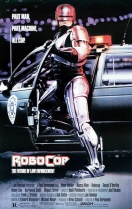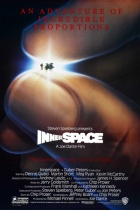 With its modest $13 million budget and domestic takings of over $50 million*, Paul Verhoeven’s RoboCop was one of the big summer hits of 1987. Its main character became a classic ’80s icon – thanks largely to Peter Weller’s compelling performance and Rob Bottin’s remarkable costume and makeup effects – and is clearly represented here on the front cover of Cinefex #32. Eagle-eyed readers will note the front cover also reflects the journal’s first price hike for several years, from $4.95 to $5.50. The back cover shows the miniature submersible from Joe Dante’s Innerspace – miniature in story terms because it’s been shrunk and injected into a human body; miniature in reality because it is in fact a highly detailed model created by Industrial Light and Magic. Together, the two films fill up this issue’s 68 pages.
With its modest $13 million budget and domestic takings of over $50 million*, Paul Verhoeven’s RoboCop was one of the big summer hits of 1987. Its main character became a classic ’80s icon – thanks largely to Peter Weller’s compelling performance and Rob Bottin’s remarkable costume and makeup effects – and is clearly represented here on the front cover of Cinefex #32. Eagle-eyed readers will note the front cover also reflects the journal’s first price hike for several years, from $4.95 to $5.50. The back cover shows the miniature submersible from Joe Dante’s Innerspace – miniature in story terms because it’s been shrunk and injected into a human body; miniature in reality because it is in fact a highly detailed model created by Industrial Light and Magic. Together, the two films fill up this issue’s 68 pages.
- Shooting RoboCop (article by Paul M Sammon)
- Inside Martin Short (article by Janine Pourroy)
Robocop
With the last few issues of Cinefex featuring either flops or films in which the visual effects weren’t front and centre, it’s refreshing to read Paul Sammon’s no-holds-barred article on sci-fi blockbuster RoboCop. Unusually, producer Jon Davison appears to have filled the role of visual effect supervisor, hiring a range of talent to solve the specific demands of the script. The high quality of the effects proves what a good job he did. Phil Tippett – responsible for a number of complex stop-motion sequences – certainly approved, commenting on RoboCop‘s ‘excellent production team … a good reflection on Jon Davison who pulled everyone together.’
 Tippett’s team created ED 209, a menacing and temperamental enforcement droid that stars in the film’s showcase effects sequences. Tippett talks us through everything from the design process to the manufacture of the stop-motion armature and its vacuformed shell. Budget restrictions forced Tippett and his co-animator Harry Walton to resort to a rear-projection approach much like that used by Ray Harryhausen in his (by then) somewhat antiquated ‘Dynamation’ process. ‘The cheapest way to do stop-motion animation is with rear projection,’ Tippett asserts, ‘because you don’t have to involve as many people in your compositing process.’
Tippett’s team created ED 209, a menacing and temperamental enforcement droid that stars in the film’s showcase effects sequences. Tippett talks us through everything from the design process to the manufacture of the stop-motion armature and its vacuformed shell. Budget restrictions forced Tippett and his co-animator Harry Walton to resort to a rear-projection approach much like that used by Ray Harryhausen in his (by then) somewhat antiquated ‘Dynamation’ process. ‘The cheapest way to do stop-motion animation is with rear projection,’ Tippett asserts, ‘because you don’t have to involve as many people in your compositing process.’
Tippett’s analysis of the pros and cons of Dynamation is enlightening, as is the list of ways he ‘really pushed [rear projection] … further than it’s ever been pushed before.’ One of these was by adding motion blur wherever possible, although his chosen method for doing this was hardly high-tech: ‘We introduced the blurs by just wiggling the puppets.’
Slightly more sophisticated was the double-pass in-camera technique his team developed to add muzzle flashes to the ED 209 puppet’s miniature machine guns. ‘The results were pretty good,’ Tippett says. ‘You don’t see a whole lot of stop-motion gunfire.’
Stop-motion aside, Sammon also gives us Rocco Gioffre on matte paintings – ‘I prefer brush painting and oils – no airbrushing’ – and Rob Bottin on the design and construction of a robot suit that Jon Davison describes as ‘one of the most interesting, most spectacular robots ever seen on screen.’ Craig Davies reminds us how, in the days before CAD and rapid prototyping, the best way to create a full-scale robot was to sculpt it in miniature, break the sculpture down into slices, trace the slices, enlarge them on a projector and then reverse the whole process at the new, larger scale. Before you know it Rob Bottin’s back again, this time teaching us how to make a false hand and blow the fingers off it … over and over again for multiple takes. Phew – the article’s nearly as action-packed as the film.
Phil Tippett closes the article by expressing a generalised disillusionment with the film business. ‘Most movie people … [are] not interested in filmmaking anymore,’ he says. ‘RoboCop wasn’t like that … from the bottom of my heart, I can’t tell you how meaningful it was to be involved finally in a motion picture where people really cared.’
If RoboCop helped Tippett come to terms with his demons then we’ve got a lot to thank it for. After running the gauntlet of Jurassic Park, during the production of which Tippett’s planned stop-motion dinosaurs were ditched in favour of CG (prompting him to lament that he – and by implication the whole art of stop-motion – was extinct), he went on to build one of the world’s premiere effect companies: Tippett Studio.
(There are indications that Tippett’s demons remained in one form or another, and that he’s found a new way to exorcise them, this time in the form of a personal stop-motion project called Mad God. Intrigued? Click here to find out more.)
Innerspace
Just as with RoboCop, the visual effects of Innerspace saw one man overseeing many. In this case, the man was ILM’s Dennis Muren. In 1987, Muren was highly regarded in the field of visual effects; these day’s he’s practically a legend. On Innerspace, his supervisory role was notably ‘hands-off’. According to model shop supervisor Bill George, ‘Instead of being directly involved with everything, [Dennis] would give us the basic ideas and just let us go with it.’ Muren himself talks at length about the advantages of maintaining a distance: not only was he ‘on call at any moment to answer questions and keep the vision on track’ but he was able to remain objective during dailies. ‘I try to put myself in the position of the director who is just visiting for the day,’ he explains.
 Muren sets the scene for the effects themselves by expounding on his overall approach to the show. With the majority of the effects sequences set inside the human body, he decided to ‘break away from compositions that we recognised – things that looked like landscapes.’ Another key decision was to achieve as much as possible in-camera. ‘There has been a feeling at ILM that many of the shots we routinely achieve could be done less expensively if we did them all in one take.’ Was this simple cost-cutting or a backlash against the VFX industry’s increasing reliance on high technology? Or perhaps it was simply a desire to go back to basics: ILM feeling the need to get down-and-dirty.
Muren sets the scene for the effects themselves by expounding on his overall approach to the show. With the majority of the effects sequences set inside the human body, he decided to ‘break away from compositions that we recognised – things that looked like landscapes.’ Another key decision was to achieve as much as possible in-camera. ‘There has been a feeling at ILM that many of the shots we routinely achieve could be done less expensively if we did them all in one take.’ Was this simple cost-cutting or a backlash against the VFX industry’s increasing reliance on high technology? Or perhaps it was simply a desire to go back to basics: ILM feeling the need to get down-and-dirty.
Our main guide through the visual effects themselves is Bill George, an inevitable choice given the film’s heavy reliance on models. George describes how the submersibles that feature so prominently in the film were miniatures manipulated like rod puppets, via go-motion or under motion control, depending on the demands of the shot. He discusses the various merits of shooting his model sets ‘dry’ (on a smoke-filled stage), ‘wet’ (immersed in the ILM cloud tank) or ‘moist’ (covered in methocel).
The preference for the ‘wet’ look meant down-and-dirty really was the order of the day. Pourroy’s article describes how fat cells were moulded from Jello (leading to the inevitable Jello fight at the end of the shoot) and documents the acquisition of a 55-gallon tub of reject ‘Slime’ from the Mattel Toy Company, to be used for general set dressing. ‘We had to shoot quickly,’ says cameraman John Fante, ‘before it all oozed away.’
George and Muren are a great double act, with the former spilling the beans on how the ILM steered cameras through rushing arterial raceways, replicated a beating human heart and made a baby (er, that is, manufactured a replica human foetus). Muren floats above the detail, providing overall context and commentary. Given this unbeatable team, it’s no wonder that, in 1987, Innerspace picked up an Oscar for Best Visual Effects.
(Just like Phil Tippett, Bill George has found a way to express himself beyond the bounds of the day job. If you haven’t yet paid it a visit, I heartily recommend a you take a trip to his charming Sci-Fi Airshow.)
The pictures
In wrapping up these retrospectives, I usually pick out my favourite photo from each article. With RoboCop I’m spoiled for choice. Is it the full-scale ED 209 droid under construction or its miniature counterpart standing on an animation table? How about a shot of Peter Weller, chin on hand, looking terminally bored while an exploding artificial arm is attached to his shoulder? Or the entirely mechanical full-torso replica of the actor going through its paces on the stage?
I think I’ll stick with the surreal image of Weller in full costume and makeup sitting in a director’s chair under an umbrella chatting casually with producer Arne Schmidt. A classic image of how movie magic looks slightly less magical on the other side of the camera.
The Innerspace images focus largely on ILM’s surreal miniatures of the human body (hang on, they’re way bigger than lifesize – does that make them maxitures?). I especially like the wide shot on page 49 showing the crew standing around the ‘artery raceway’: a giant, winding plexiglass trough that looks like a bizarre piece of installation art.
Many of the rigs and miniatures constructed in the name of visual effects probably do qualify as art in themselves. The glamorous puppets and vehicles might get saved for posterity, but most of it ends up in the trash. Mind you, given the tendency of Innerspace‘s lentil-laced fake blood recipe to sprout shoots and start growing, maybe that’s just as well …
*Figures from BoxOfficeMojo
Did you enjoy this Cinefex retrospective? If so, click here to read the others in the series.

Yet another excellent retrospective, Graham! And I must say – Phil Tippet is a legend. His movie looks really intriguing and I love Bill George’s Sci-Fi Airshow too! It’s so cool to see these vehicles doing their thing in the real world (as opposed to the reel world). 🙂
Thanks Greg. I am completely convinced the Sci-Fi Airshow is entirely real.
Paul Verhoeven !
I grew up in Germany and studied there i do everything at the background in the Media Sports Politics Films Music etc. : could you watch the movies because of Quality : screen: dvd. poster: design, colors : quality : need to be : Watch : Gone With The Wind : that movie is from 1939 : all your cameras is not in quality the screen and dvd and poster : could you do like : 16:9 and Conan too : The Legend Of Conan : that is not a title for a film : Could Be: Conan and surname : The Way Of the Warrior : or The Way Of The Legend : The Pathway Of The Legend : that is looks great : do it like : i take form everything : 65 % : 45 % once : and 10 % the rest of the life : budget : the people know my name do not ask see you later with quality : do it right : compare : and do quality ! Wishing you the best ! Great golden screen and dvd and poster in the best color quality ! Look at the screen ! Good Luck !